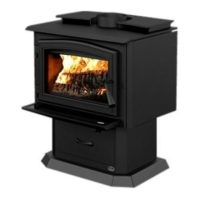Page 16
Installation and Operation Manual - 1700
ENGLISH
Softer woods make good fuel for mild weather in spring and fall because they light quickly
and produce less heat. Softwoods are not as dense as hardwoods so a given volume of wood
contains less energy. Using softwoods avoids overheating the house, which can be a common
problem with wood heating in moderate weather. Harder woods are best for colder winter
weather when more heat and longer burn cycles are desirable.
Note that hardwood trees like oak, maple, ash and beech are slower growing and longer lived
than softer woods like poplar and birch. That makes hardwood trees more valuable. The advice
that only hardwoods are good to burn is outdated. Old, leaky cast iron stoves wouldn’t hold a
fire overnight unless they were fed large pieces of hardwood. That is no longer true.
3.2 Log Length
Logs should be cut at least 1" (25 mm) shorter than the firebox so they fit
in easily. Pieces that are even slightly too long makes loading the stove very
difficult. The most common standard length of firewood is 16" (400 mm).
3.3 Piece Size
Firewood dries more quickly when it is split. Large unsplit rounds can take years to dry enough
to burn. Even when dried, unsplit logs are difficult to ignite because they don’t have the sharp
edges where the flames first catch.
.
Wood should be split to a range of sizes, from about 3" to 6" (75 mm to 150 mm) in cross
section. Having a range of sizes makes starting and rekindling fires much easier.
3.4 Compressed Wood Logs
Compressed wood logs made of 100% compressed sawdust can be
burned with caution in the number of these logs burned at once. Do
not burn compressed logs made of wax impregnated sawdust or logs
with any chemical additives. Follow the manufacturer’s instructions
and warnings.
3.5 Drying Time
Firewood that is not dry enough to burn is the cause of most complaints about wood burning
appliances. Continually burning green or unseasoned wood produces more creosote and involves
lack of heat and dirty glass door.

